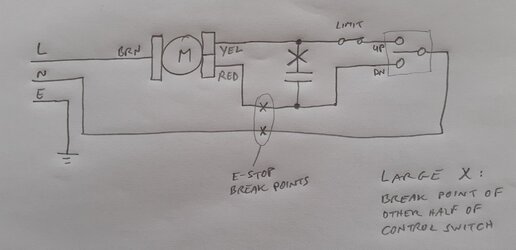- Feb 23, 2021
- 3
- 0
- 31
- If you're a qualified, trainee, or retired electrician - Which country is it that your work will be / is / was aimed at?
- United Kingdom
- What type of forum member are you?
- Electrical Enthusiast (Unqualified Hobbyist etc)
Hi all
A friend bought an extra control switch for his winch so that he'd have controls at upper and lower levels during building work. His problem was that the new switch was single pole while the switch in the original control unit was double pole (both double throw, centre return).
However, the outputs of the "extra" pole on the control switch were linked together meaning that whichever way the rocker was switched, it was connected in exactly the same way so that it's only purpose appeared to be to produce a break in the circuit when the switch was in its centre (off) position.
This break was produced in series with a capacitor which spanned the two motor coils (see picture).
My question is: Is this circuit break necessary? The way I see it, when the unit is not in use, there'll be 240v at both sides of the capacitor (through the two motor windings), so the cap will be inert (won't it?), while the motor circuit is still dead because of the control switch position.
[ If the motor windings are asynchronous (a distinct possibility in a winch) could this produce a potential difference across the cap? ]
So, yes, my question is re the necessity of this "extra" pole on the original control switch since, if it's NOT required, the job of fitting the new (single pole) switch is simple. Although one wonders why this extra expense would be added if it wasn't required...
Sorry if that was a bit rambly.
Regards
al
A friend bought an extra control switch for his winch so that he'd have controls at upper and lower levels during building work. His problem was that the new switch was single pole while the switch in the original control unit was double pole (both double throw, centre return).
However, the outputs of the "extra" pole on the control switch were linked together meaning that whichever way the rocker was switched, it was connected in exactly the same way so that it's only purpose appeared to be to produce a break in the circuit when the switch was in its centre (off) position.
This break was produced in series with a capacitor which spanned the two motor coils (see picture).
My question is: Is this circuit break necessary? The way I see it, when the unit is not in use, there'll be 240v at both sides of the capacitor (through the two motor windings), so the cap will be inert (won't it?), while the motor circuit is still dead because of the control switch position.
[ If the motor windings are asynchronous (a distinct possibility in a winch) could this produce a potential difference across the cap? ]
So, yes, my question is re the necessity of this "extra" pole on the original control switch since, if it's NOT required, the job of fitting the new (single pole) switch is simple. Although one wonders why this extra expense would be added if it wasn't required...
Sorry if that was a bit rambly.
Regards
al









